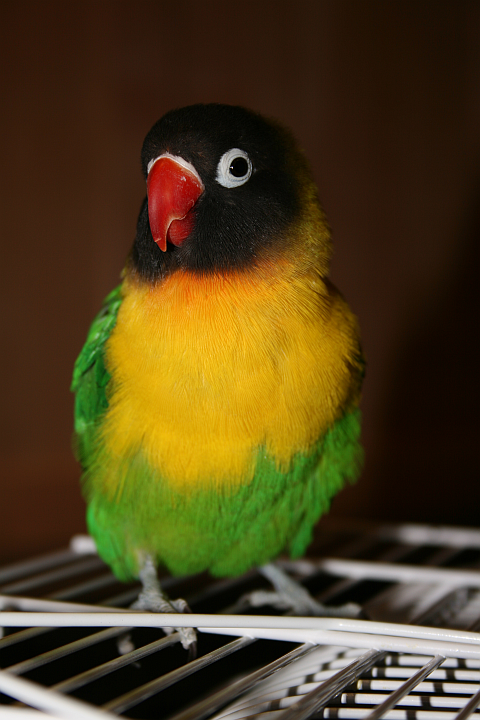Click: Captive Care of the Budgerigar (“Parakeet”), Melopsittacus undulatus; – Budgerigars as Pets – Part I, to read the first part of this article.
Feeding
 Budgerigars should be offered a mix of seed based (i.e. Pretty Bird Premium Budgie Diet) and pelleted (i.e. Zu Preem Parakeet Fruit Blend) foods. Sprouting grass (sprout pot), budgerigar treat foods and a small amount of fruit should be offered 2-3 times weekly. Cuttlebone and grit should always be available.
Budgerigars should be offered a mix of seed based (i.e. Pretty Bird Premium Budgie Diet) and pelleted (i.e. Zu Preem Parakeet Fruit Blend) foods. Sprouting grass (sprout pot), budgerigar treat foods and a small amount of fruit should be offered 2-3 times weekly. Cuttlebone and grit should always be available.
Captive Longevity
Budgerigars live an average of 5-8 years, but sometimes reach age 12 or so. The longevity record is in the neighborhood of 15 years.
Handling and Training
Birds with clipped wings are easiest to train, and hand-raised budgerigars make the best talkers.
I’ll cover the details of training in future articles, but in general it is a good idea to position the bird’s cage in a room where you spend a good deal of time, and to talk to your pet quietly at frequent intervals. Actual training sessions should be limited to 10-20 minutes.
Finger-training begins by allowing the bird to adjust to the presence of your hand within the cage. Once it accepts your presence, you can gently push against the bird’s stomach, repeating the word “up” as you do so. Eventually you should be able to remove the budgerigar from its cage.
Well-adjusted budgerigars genuinely enjoy human companionship and, in fact, may drive you to distraction with their constant play behavior (hanging from your eye-glasses while you are trying to read, for instance!).
Speaking is largely a matter of repetition – be sure to use words in context, so that your bird will appear to “know what it is talking about” once he or she does start to chatter away. Budgerigars frequently pick up words or sounds on their own, including the calls of wild birds. One kept by my grandparents frustrated my grandfather by continually calling his name in imitation of my grandmother. My slightly deaf grandfather often responded the bird’s call and ignored his wife’s – both were convinced that the budgerigar’s “chuckling” afterwards was purposeful!
Parakeets are quick to learn simple tricks (more on that in the future) but bear in mind that their natural behaviors when confronted with new objects or situations are usually well-qualified as “tricks”. Keep them in a stimulating environment and well supplied with toys and you will never want for amusement!
Breeding
Budgerigars are adapted to one of earth’s harshest environments (please see Part I of this article) and are quick to come into breeding condition when times are favorable. In captivity, well-fed and watered, they are nearly always ready to reproduce. In fact, the mere presence of a nest box may induce breeding behavior in a pair or egg-laying in a lone female.
I’ll cover breeding details in a future article, please write in if you’d like further information in the meantime.
Miscellaneous
The word budgerigar is derived from the Aboriginal term for “good eating”.
A unique article concerning experiences with budgerigars in the wild and captivity is posted at:
http://www.parrotsociety.org.au/articles/art_043.htm
 That Bird Blog – Bird Care and History for Pet Birds
That Bird Blog – Bird Care and History for Pet Birds

 Budgerigars are uniquely adapted to one of earth’s harshest environments, where rainfall and food supplies are unpredictable and may be depressed for years on end. Assuming favorable temperatures, they can breed in response to rains at any time of the year, even if such falls outside of the usual nesting season. Unlike many birds, hormonal changes bring budgerigars into breeding readiness with astonishing rapidity, thus enabling them to take advantage of the any and all reproductive opportunities. Such adaptations no doubt help to explain the budgerigar’s amazing reproductive output when kept under ideal captive conditions.
Budgerigars are uniquely adapted to one of earth’s harshest environments, where rainfall and food supplies are unpredictable and may be depressed for years on end. Assuming favorable temperatures, they can breed in response to rains at any time of the year, even if such falls outside of the usual nesting season. Unlike many birds, hormonal changes bring budgerigars into breeding readiness with astonishing rapidity, thus enabling them to take advantage of the any and all reproductive opportunities. Such adaptations no doubt help to explain the budgerigar’s amazing reproductive output when kept under ideal captive conditions. Click
Click 